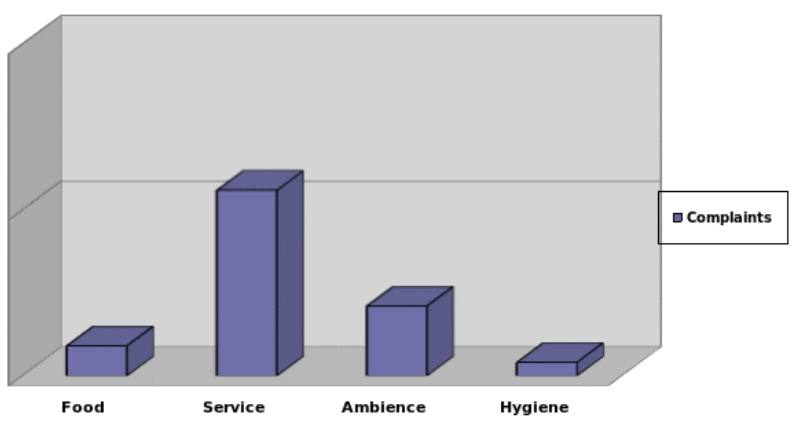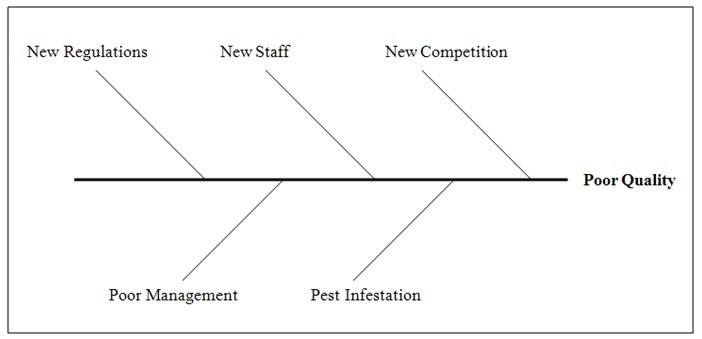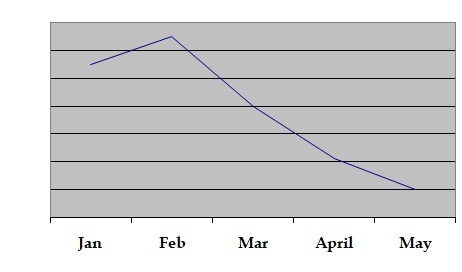Outline
- Section I: The organization under study is a restaurant which has suddenly fallen from grace and now faces a total annihilation if it does not solve its quality issues quickly. The restaurant ‘Diner Dinner’ is a public place for families and ever for 2 months, its most loyal return customers have complained and some haven’t even returned. This paper will help solve the issue at hand by identifying the source of the problem and then reaching a conclusive result which can be implemented at the restaurant.
- Section II: At least three Total Quality Management tools will be used for this assignment. A run chart will be constructed to show the profitability of the restaurant in the last 2 years and the profitability at the current state. Then a survey will be conducted from the customers to find out the reason for complaint and this will be represented by a bar chart. Finally, a root cause analysis will be done to separate the symptoms from the actual problem. (Payne, 2004)
- Section III: From the TQM tools, a through analysis will be done and alternatives for the problem will be sought from technical and non-technical staff of the organization. Some consultant help will also be sought so that all options can be professionally analyzed. A list of three best alternatives will be short listed. A complete feasibility analysis will be done from technical, operational and economic point of view and finally after further consultations and research, the best option will be implemented in the restaurant.
Term Assignment
Section I
This paper is about the application of Total Quality Management Tools in an organization to help solve a quality issue. The organization chosen is called ‘Dinner Diner’ which is a local restaurant serving local and international cuisine to its customers for over 10 years. Through this time the restaurant has developed a sense of goodwill and customers have developed a sense of affinity for the place. Most of the customers are families and the bulk of them are return customers who usually dine-in twice every month. The restaurant doesn’t have a marketing strategy yet due to good quality food and fair pricing, the word of mouth brings a lot of new customers as well.

Until recently the restaurant had been experiencing high profitability and customers, however in the last 2 months the restaurant has seen a gradual decline in the customers and the number of complaints has increased. The complaints have been about the quality of service and rude behavior of servers, high wait times in food delivery and bill payments. These complaints have not only decreased the restaurant’s customer base but have also left out coffers in need of serious monetary inflow. The diagram below shows the profitability before the complaints started rolling in.
Section II
This section will analyze the data collected from the restaurant to find out exactly where the problem lies. The survey was made at the site by asking the diners about their comments and their experience. The results of the survey proved to be alarming and disquieting for the un-knowing management of Dinner Diner. The management knew that the problem existed, however they had no idea that it was so acute. From the 90 families interviewed in one week, the amounts of complains were an alarming 56 making it more than 62% unsatisfied customers daily. The customers were questioned about the quality of food, the type of service, overall experience and cleanliness at the restaurant. The problems most concerning the customers are best represented by the graph below through the information collected by the survey.

Amongst the four factors of quality customers looked in a restaurant, quality of service was rated as the worst. As the graph shows, the second most frequent complain was about the lack of uniqueness in the environment in the restaurant while the food quality and cleanliness factors have been rated top notch by most customers. This shows that the service side of the restaurant has been lacking in the past two months.
From the above analysis it is clear that the quality of service is the problem yet to get a clearer picture of why this problem has occurred, a root-cause analysis was done through personal interviews and based on that an Ishikawa diagram was constructed. This is represented below.

From the root cause analysis several perspectives of the problem come to light. First and foremost, it is found out that several changes were made in the existing system. New regulations of closing the restaurant before time by the government because of power saving policies, change in the staff and the opening up of a new local eat out around the corner have an impact on the quality of service indirectly. Due to these constraints and competition, some employees have moved over to the other outlet. The new staff hired is not trained while the others have lost motivation to work because of same old pay packages offered. This de-motivation has resulted in poor service to the customers. The management on the other hand has turned a blind eye to these changes and continued to work as if nothing has happened until now. Another problem that may have resulted from the lack of motivation of the employees is the pest infestation that has destroyed some of the food stock. Only now the management has realized the mistake and seen its losses in terms of inflow as well as lesser customers each day. The following diagram shows the recent decline in profits of the restaurant.

Some serious remedial steps need to be taken to avoid further loss of customers and taint the image of the restaurant forever. The next section presents why customer service is such an important factor for a top-of-line restaurant and what steps can be taken to remedy, and even enhance the restaurant’s image and performance.
Section III
From the TQM tools, a through analysis was done and alternatives for the problem were sought from technical and non-technical staff of the organization. Some consultant help was also sought so that all options could be professionally analyzed. The list of three best alternatives is short listed below. Each option is rigorously tired and tested and their feasibility analyzed from a technical, operational and economic point of view. Finally, after further consultations and research, the best option is recommended which will hopefully be implemented in the restaurant to bring it back to glory.
Alternative 1
These days creating a dining experience for the customers making them come back for more means a lot more than just great food and attentive table service (Kharasch, 2007). Hiring an interior decorator to improve on the ambience makes a lot of sense especially when customers complain about ambience second most frequently. Improving the environment of the restaurant and creating a memorable experience for the customers will definitely help to compensate for the occasional sluggishness in quality of food and service. People would want to spend more time in the restaurant thus any time delays to deliver food or bills won’t even register to the customer’s minds. Also, more time the customer stays in the restaurant, more likely the chances that more orders will be made. (Rainsford and Bangs, 2000)
Alternative 2
The restaurant currently has a staff of more than 26 employees of which 18 are always on duty. The daily average customer inflow is approximately 110 while on weekends the average is around 180 when all 26 employees are required on duty. There seem to be enough servers even in the peak hours however the customers have to wait a long time. Hiring additional staff seems to be a likely option for the restaurant. Also overtime and bonus can be given to maintain the employees at crucial hours. With more chefs on hand, the food can be prepared much quicker and more servers can deliver the food to the customers quicker. Part time hiring of 2 chefs and 3 servers for weekdays and 5 chefs and 10 servers for weekends will most-likely solve the issue at hand. Part time employment will be beneficial for the restaurant for its lower cost and for the employees as well due to its flexible nature. This would also motivate other staff and help them regain the lost morale (Rainsford and Bangs, 2000)
Alternative 3
Mechanization is being used in most of the industries nowadays. In fact, now the world is moving towards incorporating information technology with the mechanization. It is only fitting for our restaurant to use both of these features synonymously to support our daily operations. Currently the restaurant kitchen chef uses frying and deep pans to cook while a single oven is used for baking and grilling the food. Purchasing two boilers and two electric ovens by replacing the old oven will be an excellent option for the restaurant. With the increased mechanization the time to cook food will go down, more food can be cooked at the same time to accommodate high demand. Also, the quality of food can be maintained since human automatic heating and cooking will be used.
Of course, the machinery will cost more however the restaurant can recover some of its investment by downsizing the workforce since there won’t be a need for six chefs then. The two chefs and the four assistants would be more than adequate to cover any peak hour demand. To increase the efficiency in the billing area, a retail type computer application would be purchased from a local software house. This system would help taking orders and will automatically generate receipts for the orders. Such mechanization and technology would require proper training costs; however, this should be thought of as an investment which would yield a higher customer base and hence higher revenue and profits. (Piccoli, 2001)
Conclusion and Recommendation
The problem that the restaurant faces currently is very severe to ignore. Turning a blind eye to it would mean saying goodbye to the restaurant as its image and reputation will plunge down and reestablishing the goodwill again will be next to impossible. The restaurant must therefore build on its prestigious name that it created as a result of hard work in the last six years of its running. Adopting mechanization and technology is the need of the hour to retain our old customer base. To attract new customers, the restaurant has to build such an experience that people want to spend more time in the restaurant. People want quick service, a welcoming environment and good food. Since the restaurant already provides a quality menu to the customers, developing the service quality and a friendly environment should be the focus.
Therefore, it is strongly recommended that the restaurant should incorporate technology and mechanization into the kitchens. This way dependency on the human factor would also decrease and more consistent food will be available to the customers. However, doing this would not be enough to attain a high customer base. Along with mechanization, the environment should also be enhanced by installing items to improve the décor of the restaurant. Creating a memorable experience for the customers is the goal and by combining these two options, this goal will be achieved easily.
Works Cited
Cara Payne (2004). Total Quality Management (TQM) Tools. Web.
David L. Goetsch, Stanley B. Davis. Quality Management 5th edition. ISBN:0-13-118929-8.
Kharasch, Isidore (2007) “Front Desk Hospitality: First Impressions Count”, Blue Boalder, Web.
Piccoli, Gabriele (2001) “The Customer-service Life Cycle: A Framework for Improving Customer Service through Information Technology”, Cornell Hotel & Restaurant Administration Quarterly, Cornell University, Volume 42, Issue 3.
Rainsford, Peter and Bangs, David H. (2000) “Restaurant Start-Up Guide”, Kaplan Business, ISBN-13: 978-1574101379.